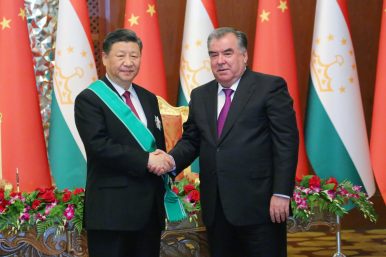By Catherine Putz
On June 15, Chinese President Xi Jinping and Tajik President Emomali Rahmon agreed to deepen their comprehensive strategic partnership, shaking hands over more than a dozen deals after meeting on the sidelines of the fifth Conference on Interaction and Confidence Building Measures in Asia (CICA) summit in Dushanbe.
According to Xinhua’s description of the joint statement issued by the two leaders, “China and Tajikistan will continue to support each other on issues concerning their core interests, such as national sovereignty, security and territorial integrity, and give priority to the development of bilateral ties in each side’s foreign policies.”
The two sides, Xinhua says, are committed to boosting security cooperation “to build a China-Tajikistan community of security step by step.”
A report today from the Wall Street Journal gives body to such statements. While the WSJ’s focus is on the grand strategic positioning between Russia and China as the United States creeps toward exiting the Afghan theater, details from an unnamed Tajik source further bolster reporting done earlier this year by the Washington Post’s Gerry Shih, underscoring that there is much more Chinese activity along the Afghanistan-Tajikistan border than Beijing admits to publicly.
In September 2016 Reuters reported on a decree published by the Tajik government referencing an agreement to be signed between the Tajik State National Security Committee and its Chinese counterparts to provide for the construction of 11 outposts and a training center.
The WSJ reports, however, that secret agreements signed in 2015 or 2016 between China and Tajikistan “gave Beijing rights to refurbish or build up to 30 to 40 guard posts on the Tajik side of the country’s border with Afghanistan.”
That China was assisting Tajikistan in border security was not a secret, but the scale and depth of that cooperation was not known.
According to the WSJ’s source:
Under the accords, Chinese border guards have replaced their Tajik counterparts along large swathes of the territory along the Tajikistan-Afghanistan border, where Beijing deems the Tajiks incapable of stopping militants potentially infiltrating Tajik territory, the official said. “There are parts of the country where the Chinese have taken over border control completely,” the official said. “They patrol on their own, in their own vehicles.”
The Chinese Foreign Ministry spokesman “said he hadn’t heard of that and noted that, when asked to comment on similar reports previously, he has said they weren’t true.”
The rest of the WSJ report puts this tidbit into a broader geostrategic context: The ever-persistent fear of “spillover” of the Afghan conflict into Central Asia and China’s deepening concerns about the security of its Belt and Road Initiative. This is good context, but another angle worth examining is the effect of Beijing’s security-first mindset and overwhelming economic influence in the region on domestic dynamics. China has not only exported its security framing to Central Asia — i.e. the “three evils” of terrorism, separatism, and religious extremism — but has done considerable work to reinforce the region’s authoritarian governments with Chinese technology.
In this vein, it’s worth pointing to a recent report from RFE/RL’s Tajik Service claiming that soon Tajikistan’s array of CCTV cameras will be equipped with artificial intelligence (AI) technology enabling them to recognize faces.
Back in May 2013, the Tajik Finance Ministry and China’s Export-Import Bank signed a $20 million, 20-year loan agreement to implement the so-called Safe City Project, which entailed the installation of Huawei CCTV systems across Dushanbe. The project was posited as traffic control; Asia Plus reported at the time that authorities claimed the loan would be repayable through traffic violation fines.
In the heat of the present U.S.-China conflagration over Huawei and increasing concerns about nefarious uses of AI technology, not to mention privacy concerns, the Safe City project takes on a different light. Is this about traffic control and safety or straight-up state surveillance? The fact of the matter is that it can be both. If China’s uses of such technology — in Xinjiang, for example — provide any lesson, it’s that Dushanbe’s bad drivers are not the only people who should be worried.
Returning to Xi and Rahmon’s tete-a-tete, the matter of sovereignty features heavily in Xinhua’s reporting. But how sovereign can Dushanbe be with Chinese troops patrolling its border, Chinese technology spying on its citizens, and Chinese loans building its infrastructure? The answer is not clear and won’t be until the moment when Tajikistan’s interests diverge significantly from those of China. That time hasn’t come yet, but that doesn’t mean it never will.

No comments:
Post a Comment